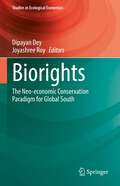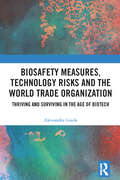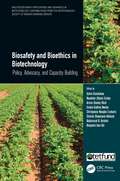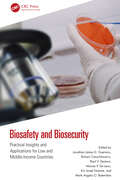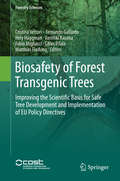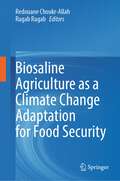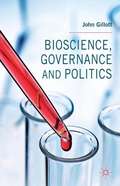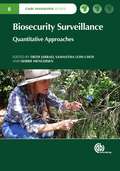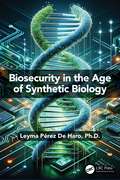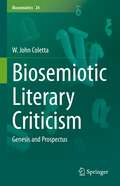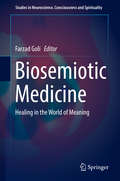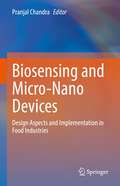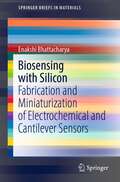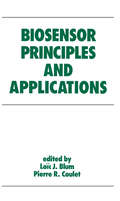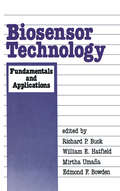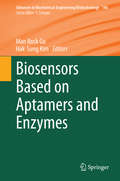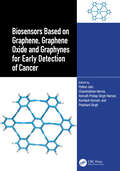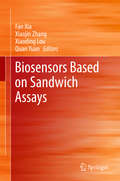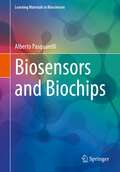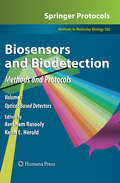- Table View
- List View
Biorights: The Neo-economic Conservation Paradigm for Global South (Studies in Ecological Economics #7)
by Joyashree Roy Dipayan DeyThis book evaluates local conservation successes of global south in the climate milieu, as an empirical evidence of ‘Bio-rights’ of commons at community-ecosystem interface for sustainable intensification of nature’s goods and services. Bio-rights is a right-based neo-economic conservation paradigm that compensates the opportunity costs incurred in conservation efforts by the marginal communities, living near globally important ecosystems and dependent on it for their livelihood, through payments from environment services. The book would bring forth the true value of circular economic interventions in socio-ecological conservation, shaped through sustainable human interactions with nature. This multilevel study of conservation science serves an interdisciplinary academia, consistent with conventions on climate change, bio-diversity and sustainable development, to establish links between conservation priorities and development objectives. Herein, Bio-rights is introduced as a ‘design approach’ for production linked sustainable development, supplemented with case studies from the east.
Biosafety Measures, Technology Risks and the World Trade Organization: Thriving and Surviving in the Age of Biotech
by Alessandra GuidaThis book examines the work of the World Trade Organization (WTO), with a focus on the capacity of its judiciary to strike a reasoned balance between free trade in biotechnology and biosafety as to promote the 2030 Agenda for Sustainable Development and its Sustainable Development Goals. By adopting an innovative interpretation of the precautionary principle and proportionality analysis, the work offers normative suggestions to develop what the author terms “a constructive bridge of knowledge” between decision-makers, scientists, social experts and expert witnesses, which can support a judicial balance by design rather than by chance. Biotechnology is sometimes regarded as a panacea for modern-day challenges, such as feeding a growing world population and counteracting climate-change problems, and a means of offering significant economic opportunities. However, biotechnology can present uncertain, though serious, risks to human health and the environment (i.e., biosafety). Trading biotech products magnifies these risks and benefits globally. This book explores the topical, though still underexplored, question of how to find a point of equilibrium between the revolutionary advancement offered by technology and the need to safeguard biosafety from uncertain, though potentially irreversible, technology risks. It offers a thorough analysis of normative, judicial and epistemic issues hindering a reasoned balance between trade and non-trade interests under the WTO. The work offers practical relevance for the resolution of legal disputes in contexts of uncertainty, as well as innovative theoretical contributions. It will be a valuable resource for policymakers working on precautionary governance and management, scholars in the areas of trade law, human rights law and environmental law, law students and practitioners, as well as NGOs working in the field of new technologies, biosafety, sustainability and food safety.
Biosafety and Bioethics in Biotechnology: Policy, Advocacy, and Capacity Building (Multidisciplinary Applications and Advances in Biotechnology)
by Sylvia UzochukwuThis book covers a range of important topics in biotechnology policy, advocacy and education, bioethics, biosafety regulations for genetically modified organisms and gene-edited products and biotechnology manpower development. Throughout the book, the contributors review biosafety and bioethical guidelines that could enhance adoption of biotechnology in alignment with national priorities and research agendas. They also discuss the importance of current biotechnology policy advocacy, enlightenment and public engagement with stakeholders and policy makers. The book will be useful reference material for scientists and researchers working in the fields of food and agricultural biotechnology, biopharmaceuticals and medical biotechnology, environmental biotechnology, biotechnology policy and advocacy, biotechnology communication and manpower development, biosafety and bioethics, etc. Emphasizes recent advances in biotechnology that could ameliorate the high-level global food insecurity through the deployment of the technology in Nigeria Provides detailed information on how to domesticate biotechnology and boost training of the biotechnology workforce in the universities and research institutes Introduces new frontiers in the area of organizing informal biotechnology capacity building courses and professional certification Reviews biosafety and bioethical guidelines that could enhance adoption of biotechnology in alignment with national priorities and research agendas Discusses current biotechnology policy advocacy, enlightenment and public engagement with stakeholders and policy makers Sylvia Uzochukwu, Ph.D., is a Professor of Food Science and Biotechnology, and Director, Biotechnology Centre, Federal University, Oye-Ekiti, Nigeria. Arinze Stanley Okoli, Ph.D., is an Associate Professor at Genoek – Centre for Biosafety, Universitetet II, Breivika, Tromsoe, Norway. Nwadiuto (Diuoto) Esiobu, Ph.D., is a Professor of Microbiology and Biotechnology at Florida Atlantic University, Boca Raton, FL, USA, and the President and Founder of Applied Biotech, Inc. and ABINL. Emeka Godfrey Nwoba, Ph.D., is currently at the Algae Research & Development Centre, Murdoch University, Western Australia. Christpeace Nwagbo Ezebuiro, Ph.D., is a Project Manager, Renewable Energy Expert and Head of Clean Technology Division at the National Biotechnology Development Agency, Abuja, Nigeria. Charles Oluwaseun Adetunji, Ph.D., is an Associate Professor of Microbiology and Biotechnology and the Director of Intellectual Property and Technology Transfer, Edo State University Uzairue, Nigeria. Abdulrazak B. Ibrahim, Ph.D., is a Capacity Development Expert at the Forum for Agricultural Research in Africa (FARA) and Associate Professor of Biochemistry, Ahmadu Bello University, Zaria, Nigeria. Benjamin Ewa Ubi, Ph.D., is a Professor of Plant Breeding and Biotechnology and Director, Biotechnology Research and Development Centre, Ebonyi State University Abakaliki, Nigeria.
Biosafety and Biosecurity: Practical Insights and Applications for Low and Middle-Income Countries
by Jonathan Jaime G. Guerrero, Rohani Cena-Navarro, Raul V. Destura, Marian P. De Leon, Kin Israel R. Notarte, and Mark Angelo O. BalendresThere are many guidelines, protocols and advisories that outline how biosafety and biosecurity can be adopted by institutions around the world. Whilst helpful, many of these are tailored to affluent Western nations. This leaves developing nations far behind since their laboratories and institutions are resource-scarce and biosafety and biosecurity are not mainstreamed entirely among the different laboratory workers, healthcare professionals, researchers, and academics. Biosafety and Biosecurity: Practical Insights and Applications for Low and Middle-Income Countries aims to bridge this gap by comprehensively summarizing the state and development of biosafety and biosecurity in developing and developed nations in a comparative analysis. This book includes basic concepts and principles of biosafety and biosecurity, including certification and legal frameworks, both international and local, and biosafety and biosecurity across disciplines including environmental, medical, and special topics that are relevant to countries with comparable conditions. This proposed book solves the problem of the lack of a prescribed professional title that comprehensively summarizes the state and development of biosafety and biosecurity throughout the world, allowing the reader a 360 view of the subject area.This book will appeal to a global audience of biorisk officers, health and safety professionals and specialists in the life sciences, health and allied fields, environmental science, engineering, and plant and animal agriculture.
Biosafety of Forest Transgenic Trees: Improving the Scientific Basis for Safe Tree Development and Implementation of EU Policy Directives (Forestry Sciences #82)
by Cristina Vettori Fernando Gallardo Hely Häggman Vassiliki Kazana Fabio Migliacci Gilles Pilate Matthias FladungThis book provides up-to-date information on the environmental impact of transgenic trees on genetically modified tree (GMT) communication strategy. It is useful to public/private organisations as well as to private and public research bodies and universities worldwide since it reports on the global status of GMT research and policy. A high number of genetically modified trees (GMTs) with altered or novel characteristics have been produced in the last 15 years. However, their very low public acceptance is a basic problem in their commercialization. Breeders anticipate economic and ecological benefits, like reduced product costs and less pressure on native forests, while opponents fear risks, such as unintended spread of GMTs. But what is true? To answer this question, the COST Action FP0905 focused on key aspects related to GMTs: (a) biological characterization; (b) assessment of possible environmental impacts; (c) socio-economic implications and public acceptance/concerns; (d) providing science-based information to communicate with the public.
Biosaline Agriculture as a Climate Change Adaptation for Food Security
by Ragab Ragab Redouane Choukr-AllahThis book presents recent research work on Biosaline Agriculture presented during First International Forum on Biosaline Agriculture in Laayoune, Morocco from May 3rd to May 4th 2019. The aim of this book is to showcase the global potential of Biosaline agriculture, provide an update on the development of recent innovations in the field of Biosaline agriculture, the best management practices to safely use brackish and saline water, highlight the use of non-conventional water in marginal environment production and the current advanced technologies of desalination of brackish and seawater. The different chapters will also discuss solutions that are adapted to local conditions as part of a sustainable development perspective. The book provides up-to-date technical and scientific data on growing crops under marginal environment so as to encourage the dissemination of this knowledge in the best practices to increase the productivity in Biosaline agriculture, in view of the potential to contribute to food security. The book is expected to stimulate interest in the non-conventional water resources and crops among junior and senior researchers and among those who are increasingly focused on exploiting marginal environments. It will also be of interest to decision-makers and the public and private sectors to jointly address the issues of food security especially of the poor and vulnerable people living in marginal environments worldwide by providing innovative technology transfer.
Bioscience, Governance and Politics
by John GillottThrough case studies, theoretical research and interviews with leading players in science and governance, this book introduces a new understanding of change in governance of bioscience research. In particular it examines change as it is shaped by approaches developed by Science and Technology Studies and Sociology of Scientific Knowledge theorists.
Bioscientific Terminology
by Donald M. AyersLessons that develop a set of guides toward understanding 'new' scientific vocabulary through examination of stems and bases, suffixes etc. A help-yourself guide for 'unlocking' unfamiliar scientific words accompanied by many examples and exercises. -The National Science Teachers Association "This new book is designed to self-teach the budding scientist the basics of the scientific language. " -The Associated Press
Biosecurity Surveillance
by Kerrie Mengersen Sama Low Choy Frith JarradThis book is a source of information on practical and innovative approaches to biosecurity surveillance. It explains the foundation and concepts behind surveillance design, with examples of methods and tools created to deal with surveillance challenges. With supporting case studies and including current directions in research, it covers evidence-based approaches to surveillance, statistics, detectability, single and multi-species detection, risk assessment, diagnostics, data-basing, modelling of invasion and spread, optimisation, and future climate challenges.
Biosecurity Surveillance: Quantitative Approaches (CABI Invasives Series)
by Kerrie Mengersen Frith Jarrad Samantha Low-ChoyThis book provides practical and innovative approaches to biosecurity surveillance. It explains the foundation and concepts behind surveillance design, with examples of methods and tools created to deal with surveillance challenges. With supporting case studies, it covers detectability, single and multi-species detection and risk assessment.
Biosecurity in the Age of Synthetic Biology
by Leyma Pérez De HaroBiosecurity in the Age of Synthetic Biology is a comprehensive review of the biosecurity issues faced by the innovative and rapidly evolving field of synthetic biology. This is a meticulous review of the groundbreaking biotechnological advancements and the critical need for robust biosecurity measures. The book provides an in-depth examination of the ethical, legal, and societal dimensions shaping the future of synthetic biology research, in addition to a practical protocol for biosecurity risk assessment. This is the first book to offer a structured guideline for biosecurity risk assessment in synthetic biology. The author’s balanced view of the opportunities of synthetic biology and the inherent security risks reveals foundational concepts, cutting-edge applications, and international perspectives on biosecurity. This essential guide illuminates scientific and technological frontiers and advocates for a proactive approach ensuring the responsible development and use of synthetic biology. It is an indispensable resource for scientists, policymakers, and anyone interested in the intersection of biotechnology and biosecurity.Key Features: Provides instructions and examples for a biosecurity risk assessment. Includes detailed proposed outline for creating a Biosecurity Manual for broad adoption. Emphasizes the future challenges and opportunities. Offers insights on the role of artificial intelligence in synthetic biology and biosecurity.
Biosemiotic Literary Criticism: Genesis and Prospectus (Biosemiotics #24)
by W. John ColettaThis volume is based to a large extent on the understanding of biosemiotic literary criticism as a semiotic-model-making enterprise. For Jurij Lotman and Thomas A. Sebeok, “nature writing is essentially a model of the relationship between humans and nature” (Timo Maran); biosemiotic literary criticism, itself a form of nature writing and thus itself an ecological-niche-making enterprise, will be considered to be a model of modeling, a model of nature naturing. Modes and models of analysis drawn from Thomas A. Sebeok and Marcel Danesi’s Forms of Meaning: Modeling Systems Theory and Semiotic Analysis as well as from Timo Maran’s work on “modeling the environment in literature,” Edwina Taborsky’s writing on Peircean semiosis, and, of course, Jesper Hoffmeyer’s formative work in biosemiotics are among the most important organizing elements for this volume.
Biosemiotic Medicine: Healing in the World of Meaning (Studies in Neuroscience, Consciousness and Spirituality #5)
by Farzad GoliThis book presents an interpretation of pharmaceutical, surgical and psychotherapeutic interventions based on a univalent metalanguage: biosemiotics. It proposes that a metalanguage for the physical, mental, social, and cultural aspects of health and medicine could bring all parts and aspects of human life together and thus shape a picture of the human being as a whole, made up from the heterogeneous images of the vast variety of sciences and technologies in medicine discourse. The book adopts a biosemiotics clinical model of thinking because, similar to the ancient principle of alchemy, tam ethice quam physice, everything in this model is physical as much as it is mental. Signs in the forms of vibrations, molecules, cells, words, images, reflections and rites conform cultural, mental, physical, and social phenomena. The book decodes healing, dealing with health, illness and therapy by emphasizing the first-person experience as well as objective events. It allows readers to follow the energy-information flows through and between embodied minds and to see how they form physiological functions such as our emotions and narratives.
Biosemiotic Perspectives on Language and Linguistics (Biosemiotics #13)
by Ekaterina Velmezova Kalevi Kull Stephen J. CowleyThe first international volume on the topic of biosemiotics and linguistics. It aims to establish a new relationship between linguistics and biology as based on shared semiotic foundation.
Biosemiotics and Evolution: The Natural Foundations of Meaning and Symbolism (Interdisciplinary Evolution Research #6)
by Elena Pagni Richard Theisen SimankeThis book reviews the evolution of Biosemiotics and gives an outlook on the future of this interdisciplinary new discipline. In this volume, the foundations of symbolism are transformed into a phenomenological, technological, philosophical and psychological discussion enriching the readers’ knowledge of these foundations. It offers the opportunity to rethink the impact that evolution theory and the confirmations about evolution as a historical and natural fact, has had and continues to have today. The book is divided into three parts:Part I Life, Meaning, and InformationPart II Semiosis and EvolutionPart III Physics, medicine, and bioenergetics It starts by laying out a general historical, philosophical, and scientific framework for the collection of studies that will follow. In the following some of the main reference models of evolutionary theories are revisited: Extended Synthesis, Formal Darwinism and Biosemiotics. The authors shed new light on how to rethink the processes underlying the origins and evolution of knowledge, the boundary between teleonomic and teleological paradigms of evolution and their possible integration, the relationship between linguistics and biological sciences, especially with reference to the concept of causality, biological information and the mechanisms of its transmission, the difference between physical and biosemiotic intentionality, as well as an examination of the results offered or deriving from the application in the economics and the engineering of design, of biosemiotic models for the transmission of culture, digitalization and proto-design. This volume is of fundamental scientific and philosophical interest, and seen as a possibility for a dialogue based on theoretical and methodological pluralism. The international nature of the publication, with contributions from all over the world, will allow a further development of academic relations, at the service of the international scientific and humanistic heritage.
Biosensing and Micro-Nano Devices: Design Aspects and Implementation in Food Industries
by Pranjal ChandraThis book reviews applications of nanomaterial and nanodevices in the food industry. It also discusses the advanced bioanalytical techniques, including Enzyme-Linked Immunosorbent Assay (ELISA), immunoanalytical techniques, and monoclonal antibody-based immunological techniques for detecting food adulterations and allergens. It comprehensively covers electrode modification and nano-engineered fabrication of biosensors to enhance their functionalities for utilization in food industries. The book highlights the utilization of nanobiosensors for food safety and quality analysis, such as detection of toxin, food-borne pathogen, allergen, evaluation of toxicity etc. Further, it also summarizes the recent advances in nanodevices such as nano-systems, nano-emulsions, nanopesticides, and nanocapsules and their applications in the food industry. Lastly, it covers nanomaterial-based sensors for drug analysis in diverse matrices. It serves as an invaluable source of information for professionals, researchers, academicians, and students related to food science and technology.
Biosensing with Silicon: Fabrication and Miniaturization of Electrochemical and Cantilever Sensors (SpringerBriefs in Materials)
by Enakshi BhattacharyaThis book discusses two silicon biosensors: an electrochemical sensor – the Electrolyte Insulator Silicon Capacitor (EISCAP), and a mechanical resonant cantilever sensor. The author presents the principle and the technology behind the device fabrication and miniaturization, stable and reproducible functionalization protocols for bioreceptor immobilization, and the measurement and the data analysis for extracting the best performance from these sensors.EISCAP sensors, used for the estimation of triglycerides and urea, have been improved through the use of micromachining processes. The miniaturization brought out advantages as well as challenges which are discussed in this book, resulting in a prototype mini-EISCAP with a readout circuit for fast and accurate estimation of triglycerides. The author also reports on the sensitivity improvements in the estimation of triglycerides and urea obtained with the polycrystalline silicon cantilever and its measurements in liquid media.The book is ideal for materials scientists and engineers working in the field of biosensors and MicroElectroMechanical systems (MEMS) and their optimizations, as well as researchers with biochemical or biomedical expertise, in order to have a fresh and updated review on the last progresses reached with EISCAPs and cantilever sensors.
Biosensor Principles and Applications (Biotechnology And Bioprocessing Ser.)
by Pierre R. Coulet Loïc J. BlumConsiders a new generation of sensors for use in industrial processes, which measure the chemical environment directly by means of a biological agent mainly enzymes so far. Various specialists from Europe, the US, and Japan identify the device's place in their disciplines; review the principles of m
Biosensor Technology: Fundamentals and Applications
by BuckThis authoritative reference covers recent advances in the field, stressing an interdisciplinaryapproach to the development and use of biosensor technology in physics,engineering, analytical chemistry, and biochemistry (including immunochemistry).about the editors ...RICHARD P. BucK is a Professor in the Chemistry Department, University of Northcarolina, Chapel Hill. Professor Buck serves on the editorial boards of severaljournals including Analytical Instrumentation: Applications and Designs for Chemica~Biomedica~ and Environmental Science (Marcel Dekker, Inc.). He is a member of theAmerican Chemical Society, Electrochemical Society, and International Society ofElectrochemistry. He received the B.S. (1950) and M.S. (1951) degrees from thecalifornia Institute of Tochnology, Pasadena, and Ph.D. degree (1954) from theMassachusetts Institute of Tochnology, cambridge.W1WAM E. HATFIELD is Mary Ann Smith Professor and Vice Chairman of Chemistry,and Acting Chairman of the Curriculum in Applied Sciences, University of Northcarolina, Chapel Hill. He is the author or coauthor of over 300 publications, andcoeditor, with John H. Miller, Jr., of High-Temperature Superconducting Materials:Preparations, Properties, and Processing (Marcel Dekker, Inc.). He is a member of theAmerican Chemical Society, American Association for the Advancement of Science,and Materials Research Society. He received the B.S. (1958) and M.S. (1959) degreesfrom Marshall University, Huntington, West Virginia, Ph.D. degree (1962) from theUniversity of Arizona, Tucson, and completed postdoctoral research at the Universityof Illinois, Urbana.M1KTHA UMANA is an independent consultant to Glaxo Inc. and Research 'IriangleInstitute, Research 'Iriangle Park, and Duke University Engineering Research Center,Durham, North carolina. The coauthor of numerous scientific journal articles, herresearch interests include surface chemistry, electrochemistry, and biosensors. Shereceived the B.Sc. degree (1969) from the University of Chile, Santiago, and Ph.D.degree (1972) from the University of London, England.EDMOND E BowoEN is an Associate Professor in the Department of Chemistry andin the Biotechnology Program, North carolina State University, Raleigh. Thecoauthor of numerous journal articles, his research interests include bioelectrochemistry,biological electron transfer, biosensors, and surface chemistry. He receivedthe B.S. degree (1970) from Syracuse University, Syracuse, New York, and Ph.D.degree (1982) from Virginia Commonwealth University, Richmond.
Biosensors Based on Aptamers and Enzymes (Advances in Biochemical Engineering/Biotechnology #140)
by Man Bock Gu Hak-Sung KimVolumes are organized topically and provide a comprehensive discussion of developments in the respective field over the past 3-5 years. The series also discusses new discoveries and applications. Special volumes are dedicated to selected topics which focus on new biotechnological products and new processes for their synthesis and purification. In general, special volumes are edited by well-known guest editors. The series editor and publisher will however always be pleased to receive suggestions and supplementary information. Manuscripts are accepted in English.
Biosensors Based on Graphene, Graphene Oxide and Graphynes for Early Detection of Cancer
by Chandrabhan Verma Pallavi Jain Prashant Singh Anirudh Pratap Singh Raman Kamlesh KumariThe detection of cancer at its earliest stages is paramount for successful treatment and improved patient outcomes. In recent years, the field of nanotechnology has witnessed significant advancements, and one material that has emerged as a potential game-changer in cancer detection is graphene. Graphene's high surface area, excellent electrical conductivity, and ability to interact with biological molecules have paved the way for innovative approaches to diagnosing cancer. Moreover, graphene oxide, a derivative of graphene, has gained significant attention in the field of cancer detection. Its unique properties, including biocompatibility and high photothermal conversion efficiency, enable its use in various imaging techniques. Graphene oxide can selectively accumulate in tumor tissues, enhancing the contrast signals in imaging modalities like optical imaging, magnetic resonance imaging (MRI), and photoacoustic imaging. This allows for precise visualization and localization of cancerous cells or tissues, aiding in early detection and accurate diagnosis.Features: Provides a comprehensive exploration of carbon, its allotropes, and its significance in emerging applications. Discusses the synthesis and functionalization of graphene on diverse substrates, and modeling approaches employed in graphene research. Details the application of graphene, graphene oxide, and graphyne-based materials on cancer detection. Explores the overview of the wider biological applications of carbon-based materials. This book will serve as a valuable reference source for researchers, academics, and biologists working in R&D and interested in biosensing for the early detection of cancer.
Biosensors Based on Nanomaterials and Nanodevices (Nanomaterials and their Applications)
by AntonioBiosensors Based on Nanomaterials and Nanodevices links interdisciplinary research from leading experts to provide graduate students, academics, researchers, and industry professionals alike with a comprehensive source for key advancements and future trends in nanostructured biosensor development. It describes the concepts, principles, materials, device fabrications, functions, system integrations, and applications of various types of biosensors based on signal transduction mechanisms, including fluorescence, photonic crystal, surface-enhanced Raman scattering, electrochemistry, electro-luminescence, field-effect transistor, and magnetic effect. The book: Explains how to utilize the unique properties of nanomaterials to construct nanostructured biosensors to achieve enhanced performance Features examples of biosensors based on both typical and emerging nanomaterials, such as gold nanoparticles, quantum dots, graphene, graphene oxides, magnetic nanoparticles, carbon nanotubes, inorganic nanowires/nanorods, plasmonic nanostructures, and photonic crystals Demonstrates the broad applications of nanostructured biosensors in environmental monitoring, food safety, industrial quality assurance, and in vitro and in vivo health diagnosis Inspires new ideas for tackling multiscale and multidisciplinary issues in developing high-performance biosensors for complex practical biomedical problems Focusing on the connection between nanomaterials research and biosensor development, Biosensors Based on Nanomaterials and Nanodevices illustrates the exciting possibilities and critical challenges of biosensors based on nanomaterials and nanodevices for future health monitoring, disease diagnosis, therapeutic treatments, and beyond.
Biosensors Based on Sandwich Assays
by Fan Xia Xiaojin Zhang Xiaoding Lou Quan YuanThis book shows the various sandwich assays that are constructed from recognition molecules, such as antibodies, oligonucleotide sequences and aptamers, developed as a result of nano- and biotechnology advances. It consists of ten chapters presenting interesting examples of these assays, organized according to the type of analytic methods (colorimetric, fluorescence, electrochemical, etc. ) and detected objects (protein, nucleic acid, small-molecule, ion, etc. ). It also includes a chapter discussing the introduction of sandwich assays as biosensors for the detection of a range of targets. It is an interesting and useful resource for a wide readership in various fields of chemical science and nanotechnology.
Biosensors and Biochips (Learning Materials in Biosciences)
by Alberto PasquarelliThis textbook describes the basic principles and mechanism of action of biosensor systems, and introduces readers to the various types of biosensors; from affinity biosensors to catalytic, optical and label-free biosensors, the most common systems are explained in detail. Dedicated advanced sections focus on biochips and genome sequencing methods as well as organs-on-a-chip. The textbook helps readers to understand the elementary components of biosensors, and to identify and illustrate each function in the biosensor information flow, from recognition to transduction and transmission. Furthermore, readers will receive guidance in critically analyzing published studies on biosensor research, helping them to develop appropriate concepts and independently propose their own solutions. The textbook is intended for master’s students in bioengineering, biophysics, biotechnology and pharmacology that need a solid grasp of biosensor system technologies and applications, as well as students in related medical technological fields.
Biosensors and Biodetection - Methods and Protocols Volume 1: Methods and Protocols Volume 1: Optical-Based Detectors (Methods in Molecular Biology #503)
by Keith Herold Avraham RasoolyBiosensors combine biological recognition elements and signal conversion elements into a biodetection system. They have been developed for a wide variety of biodetection applications, offering the advantages of increased speed and ease of use compared to traditional detection methods. In Biosensors and Biodetection: Methods and Protocols, leading experts describe the major technologies in the field in extensive technical detail, allowing readers both to understand the technology and to construct similar devices. Volume 1: Optical-Based Detectors delves into direct and indirect optical detectors, including methods involving surface plasmon resonance, interferometric sensors, CCD based detectors, and spectrometers, among many other cutting-edge technologies. Written in the highly successful Methods in Molecular BiologyTM series format, chapters include brief introductions to the subjects, lists of the necessary materials, step-by-step, readily reproducible protocols, and Notes sections, which highlight tips on troubleshooting and avoiding known pitfalls.<P><P> Comprehensive and up-to-date, Biosensors and Biodetection: Methods and Protocols is an ideal, user-friendly guide to this vital, versatile technology and a perfect tool for those who wish to further the field.
